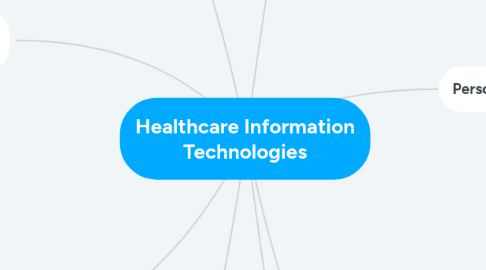
1. Patient Portal
1.1. Some of the information available from patient portals includes: Reports from recent doctor visits Results of lab tests Discharge summaries Immunization records Allergies Patient education materials Secure email Prescription refill ordering Information on benefits and coverage Self-serve updates of patient information Downloadable forms Payment processing
2. Health Information Exchange (HIE)
2.1. There are three HIE architecture types: federated or decentralized, centralized, and hybrid.
2.1.1. In a federated model, health records are stored in independent databases or repositories. Each healthcare organization or provider maintains ownership of and control over the health records; access to the health record is granted to users only when needed.
2.1.2. In a centralized model, health records are collected from participants in the HIE and stored in a single repository or database.
2.1.3. A hybrid model combines centralized and decentralized aspects.
2.2. There are two methods of data exchange in HIE: push and pull.
2.2.1. When a message or document, such as a lab result, is sent from one participant to another, this is called a push exchange.
2.2.2. When a provider searches for or queries a patient's health information, this is called a pull exchange.
2.3. The types of data that can be exchanged include clinical, claims, public health, quality and reporting data.
3. Population Health Management (PHM)
3.1. The main technology that makes PHM possible is business intelligence and data analytics.
3.1.1. These technologies are needed because in order to truly achieve the goals of PHM, clinical, financial and operational data needs to be brought together from across the organization as well as provide actionable steps for providers via analytics -- including predictive analytics. Effective PHM technologies and programs will provide real-time insights, allowing providers to identify and address any care gaps within the patient population. This will allow a healthcare organization to improve patient outcomes and cost savings.
4. Picture Archiving and Communication Systems (PACS)
4.1. PACS has four major components: hardware imaging machines; a secure network for the distribution and exchange of patient images; a workstation or mobile device for viewing, processing and interpreting images; and electronic archives for storing and retrieving images and related documentation and reports.
4.2. PACS has four main uses. The technology:
4.2.1. Replaces the need for hard-copy films and management of physical archives.
4.2.2. Allows for remote access, enabling clinicians in different physical locations to review the same data simultaneously.
4.2.3. Offers an electronic platform for images interfacing with other medical automation systems such as a hospital information system (HIS), electronic health record (EHR), and radiology information system (RIS).
4.2.4. Allows radiologists and other radiology and medical personnel to manage the workflow of patient exams.
5. Electronic Health Record (EHR)
5.1. The ability to automatically share and update information among different offices and organizations
5.2. More efficient storage and retrieval
5.3. The ability to share multimedia information, such as medical imaging results, between locations
5.4. The ability to link records to sources of relevant and current research
5.5. Easier standardization of services and patient care
5.6. The ability to aggregate patient data for population health management and quality of care programs
5.7. Provision of decision support systems for healthcare professionals
5.8. Less redundancy of effort
5.9. Potential long-term lower costs to medical systems
6. Personal Health Record (PHR)
6.1. Improved patient engagement: Having information and tools to manage health and the ability to track health over time helps involve patients in their own healthcare. Furthermore, much of what patients do for their health happens outside the four walls of a doctor's office. PHRs allow the patient to document these events.
6.2. Better access to patient information: In emergencies or when a patient is traveling, PHRs help ensure their health information is available to them whenever they need it.
6.3. Improved management of information from multiple providers: PHRs help patients manage information from various providers and can help improve care coordination.
6.4. Reduced administrative costs: PHRs reduce the burden on healthcare organizations such that staff will spend less time searching for patient-requested information and responding to patient questions.
6.5. Better patient-provider communication: PHRs can improve communication between the patient and physicians by providing direct, secure communication methods.
6.6. Ability to manage family healthcare: PHRs can help caregivers, including family members, better manage the patient's care and help coordinate with other caregivers.
7. Vendor Neutral Archives (VNAs)
7.1. VNAs reduce isolated groups of storage dedicated to individual PACS and instead promote cross-enterprise document sharing and exchange. Some of the benefits provided by a VNA include:
7.1.1. The freedom to access big data from different PACS, and to change a PACS without requiring complex data migration methods.
7.1.2. Effective control of image data.
7.1.3. Improved clinical and data workflows.
7.1.4. Easier integration of new imaging applications, including those not supplied by a provider's current PACS vendor.
8. Telemedicine
8.1. Telemedicine can be classified into three main categories: remote patient monitoring, store-and-forward, and interactive telemedicine.
8.1.1. Remote patient monitoring, also known as telemonitoring, allows patients with chronic diseases to be monitored in their homes with mobile medical devices that collect data about blood sugar levels, blood pressure or other vital signs. Remote caregivers can review the data instantly.
8.1.2. Store-and-forward, also known as asynchronous telemedicine, lets providers share patient information, such as lab results, with a physician at another location.
8.1.3. Finally, interactive telemedicine allows physicians and patients to communicate in real time. Such sessions can be conducted in the patient's home or in a nearby medical facility and include telephone conversations or the use of video conferencing software that complies with HIPAA regulations.
